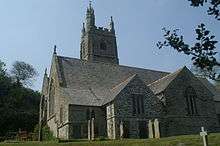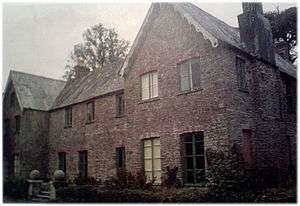St Mawgan
Coordinates: 50°27′18″N 4°59′53″W / 50.455°N 4.998°W

_and_its_history_-_geograph.org.uk_-_894668.jpg)

St Mawgan in Pydar (Cornish: Lanherne) is a civil parish in Cornwall, England, United Kingdom. The population of this parish at the 2011 census was 1,307.[1] The village of St Mawgan is situated four miles northeast of Newquay, and the parish also includes the hamlet of Mawgan Porth.[2] The nearby Royal Air Force station, RAF St. Mawgan, takes its name from the village and is next to Newquay Cornwall Airport. The River Menalhyl runs through St Mawgan village and the valley is known as The Vale of Lanherne.[2] It was the subject of a poem by poet Henry Sewell Stokes.
Parish church
St Mawgan also has a 13th-century parish church, dedicated to St Mauganus and St Nicholas. The church was originally a cruciform building of the 13th century but was enlarged by a south aisle and the upper part of the tower in the 15th. The unusual rood screen and bench ends are noteworthy and there are many monumental brasses to members of the Arundell family; these include George Arundell, 1573, Mary Arundell, 1578, Cyssel and Jane Arundell, c. 1580, Edward Arundell (?), 1586,[3] The Arundell brasses are mostly in a fragmentary state; parts of some of those originally in the church have been removed to Wardour Castle.[4] (St Mauganus was a Welshman and is also honoured at Mawgan, in Meneage, in Kerrier, and in Wales and Brittany.)[5]
Historic estates
Lanherne
The manor of Lanherne was long a seat of the Arundell family "of Lanherne", lords of the manor of St Mawgan, chief landowners in the parish since the 13th century, many of whose monuments survive in the parish church. They were a branch of the prominent and widespread Arundell family also seated at Trerice, Tolverne, Menadarva in Cornwall and at Wardour Castle in Wiltshire. Lanherne House has been the Lanherne Convent since 1794.
Nanskeval

Nanskeval House was on the parish boundaries of St Mawgan in Pydar (it was demolished in the mid-1970s) and St Columb Major: in 1277 it was spelt Nanscuvel. Nanskeval House was once the home of Liberal MP Edward Brydges Willyams and is still part of the Carnanton estate which is still owned by descendants of the same family. Nans means 'valley' in Old Cornish, and Kivell was thought to derive from the Cornish equivalent of the Welsh word ceffyl, meaning a horse.[6] but as the Cornish for horse is Margh this is an erroneous interpretation. Much more likely is "The valley of the Woodcock" as the Cornish for woodcock is 'Kevelek'. The surname Nankivell and its variants are thought to derive from this place.
Amenities
There are in the village two pubs, The Falcon Inn and The Airways: also at St Mawgan is a bonsai tree nursery and a Japanese Garden attraction, plus a small craft shop. There are two local cricket teams which play Sunday friendlies, the Vale of Lanherne C.C. and St Mawgan C.C.
Antiquities
Arthur Langdon (1896) recorded two Cornish crosses in the parish: one, a small cross, is at Mawgan Cross and the other at Lanherne. The Lanherne cross is a highly ornamented example and stands in the grounds of the nunnery having been brought from Roseworthy in the parish of Gwinear. "It is the most beautiful specimen of an elaborately decorated cross in Cornwall."[7] Andrew Langdon (1994) records four crosses. These are the Lanherne cross, the churchyard cross, Bodrean Cross and Mawgan Cross. The churchyard cross is the best preserved medieval lantern cross in Cornwall. Bodrean Cross (a cross head and small part of the shaft) was found in 1904 at Bodrean Farm in the parish of St Clement. In 1906 the cross head was provided with a new shaft and set up in St Mawgan churchyard.[8]
Education and recreation
The parish has one small primary school: St Mawgan-in-Pydar Primary School. Secondary education is provided by schools in Newquay.
Notable residents
Arundells of Lanherne
- Sir John Arundell of Lanherne alias John FitzAlan, 1st Baron Arundel (died 1379), naval commander and Lord Marshal of England
- John Arundell (1366 - 1435)
- John Arundell (of Lanherne, died 1423), MP for Cornwall (UK Parliament constituency),1404,1406,1411,1414,1416,1417,1422 and 1423
- John Arundell (1474–1545) of Lanherne, Receiver General of the Duchy of Cornwall
- Sir John Arundell (of Lanherne, died 1557), MP for Cornwall, 1554
- John Arundell (of Lanherne, died 1590), MP for Helston, Shaftesbury, Preston and Cornwall
Other
- Gerry Cawley, wrestling champion
References
- ↑ "2011 census for Mawgan in Pydar". Retrieved 5 February 2015.
- 1 2 Ordnance Survey: Landranger map sheet 200 Newquay & Bodmin ISBN 978-0-319-22938-5
- ↑ Dunkin, E. (1882) Monumental Brasses. London: Spottiswoode; pp. 42-53, pl. XXXVI-XLI
- ↑ Pevsner, N. (1970) Cornwall; 2nd ed. revised by Enid Radcliffe. Harmondsworth: Penguin; p. 115
- ↑ Doble, G. H. (1962) The Saints of Cornwall: part 2. Truro: Dean and Chapter; pp. 34-44
- ↑ Ceffyl (in Welsh)
- ↑ Langdon, A. G. (1896) Old Cornish Crosses. Truro: Joseph Pollard; pp. 211 & 357-59
- ↑ Langdon, A. G. (2002) Stone Crosses in Mid Cornwall; 2nd ed. Federation of Old Cornwall Societies; pp. 55-57